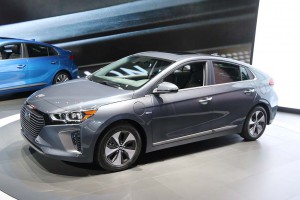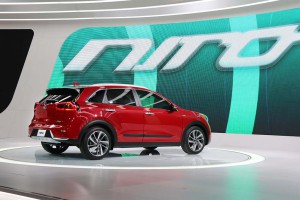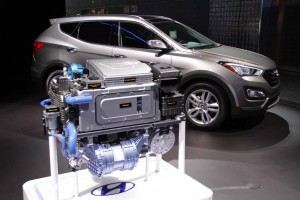
The Hyundai Ioniq makes its debut at the NY Auto Show. Hybrid, plug-in and EV versions will be offered.
When Hyundai pulled the wraps off its new Ioniq model last month, it offered three different alternative flavors: a conventional hybrid, a plug-in and a pure battery-electric version. But that’s just the beginning of the Korean carmaker’s green car push.
Within the next four years, Hyundai Motor Group – including both the Hyundai, Kia and Genesis brands – intends to flood the market with 26 green machines, including both battery and hydrogen-powered models.
The move is a risky one, especially in light of current, low gas prices that could stay depressed for several more years. But if Hyundai can pull it off, only Toyota would offer more models using alternative powertrain technology.
Hyundai was a late entrant into the green space, and all battery and hydrogen-powered models in its current line-up account for barely 1% of its total global volume, eco-car chief Lee Ki-Sang tells Automotive News. Though he declined to reveal specific targets, he projected demand would quadruple by 2020, which would work out to around 300,000 vehicles annually.
(Click Here to check out the new Hyundai Ioniq.)
According to Automotive News, The Hyundai brand’s worldwide hybrid and plug-in sales totaled 42,900 last year, while sales of its Tucson Fuel-Cell Vehicle came to just 300. The Kia brand sold 18,735 hybrids and 8,450 of its Soul EV models. Toyota sold 1.2 million battery-based vehicles, primarily the Prius hybrid.
The new Ioniq is the Hyundai brand’s first big salvo. As Toyota did with Prius, the Korean maker has opted for a unique design that will only be used for its various battery-based powertrains. Sibling Kia, meanwhile, launched the new Niro earlier this year. It will initially be sold in hybrid form, but a plug-in version is set to follow about a year from now.
(Kia rolls out new Niro hybrid, with plug-in to follow. Click Here for more.)
The ramp-up at Hyundai is “really difficult for us,” said Lee, noting that the Korean carmaker is taking several steps to reduce costs and expand its options. Among other things, the various new green models will, wherever possible share key components.
“All our electric motors have the same diameter,” he noted in his interview. “The power output is different, but we can just adjust the width of the core winding. Or for the motor controller, we standardized to use the same printed circuit boards.”
By maximizing economies of scale, Lee added, “Our target is before 2020, we would like to make profits on these eco-friendly vehicles.”
That would be a major accomplishment. Even green giant Toyota struggled for years to get its best-selling hybrid, the Prius, into the black, according to industry analysts. And most manufacturers are believed to be losing money on their more advanced plug-ins and battery-electric models. Fiat Chrysler CEO Sergio Marchionne went so far as to suggest he’d be happy if consumers didn’t buy the little Fiat 500 EV because it lost the company so much money.
According to Lee, Hyundai and Kia will divvy up the 26 planned green vehicles, a mix expected to include 12 hybrids, six plug-ins, two pure battery-electric vehicles and two hydrogen cars. He did not say whether any of those will carry the new Genesis badge. But considering luxury rivals such as Mercedes-Benz, BMW, Audi and Lexus are all planning various battery-based offerings, that could be in the works.
(Toyota back in the plug-in market with Prius Prime. Click Here for a closer look.)


